Papers by Catherine Gilliss

Pediatrics, 1994
Enteropathogens associated with outbreaks of diarrhea in child day-care centers can be spread by ... more Enteropathogens associated with outbreaks of diarrhea in child day-care centers can be spread by the fecal-oral route through hands or environmental objects that are contaminated. The purpose of this study was to determine the prevalence of fecal coliform contamination in day-care centers. During a 6-month period, on four separate occasions, cultures were taken from environmental surfaces and the hands of children and teachers at six licensed day-care centers. Fecal coliforms were recovered from 64 (9.5%) of the 675 surfaces sampled. Recovery rate was not influenced by the socioeconomic status of the clientele, time of year, or presence of children who were not toilet trained. All children wore paper diapers. Recovery rates did differ significantly for different areas: the kitchen showed a relatively high recovery rate (19%), and toys and toilets showed remarkably low rates (2% and 4%, respectively). Centers with formal hand-washing procedures had lower recovery rates than those wit...

American Journal of Critical Care, 2002
Despite increasing survival for adults with congenital heart disease, little is known about hospi... more Despite increasing survival for adults with congenital heart disease, little is known about hospitalization for young adult patients with this disease and for their families. Because of the complexity of the disease and its management during the life span, young adults are often hospitalized on both pediatric and adult units during a stay in the hospital. To explore the experience of hospitalization of young adults with congenital heart disease, the experience of their families, and the views of the nurses who cared for these patients and to generate substantive theory on interactions between patients, patients' families, and nurses. Semistructured interviews and naturalistic observations were conducted with young adults with congenital heart disease (mean age, 28.6 years), their family members, and nurses who cared for the patients during hospitalization (N=34). Dimensional analysis was used to analyze interviews and field notes from observations. A grounded theory was derived, explaining how the hospital context and relationships between patients, patients' families, and nurses affect patients' hospital experiences. Expectations differed among the groups, leading to dissonance in care, as exemplified by role confusion and power struggles over control of care. This dissonance resulted in interpersonal conflict, distrust, anxiety, and dissatisfaction with the care and caring experiences. Changes in hospital units, a better understanding of the healthcare needs of young adults with congenital heart disease, and acknowledgment of the expertise of patients and patients' families are needed to improve nursing care for these patients and their families.
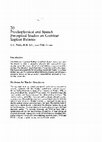
The Nursing clinics of North America, 1984
Based on the findings of this study of couples after coronary artery bypass surgery, there are nu... more Based on the findings of this study of couples after coronary artery bypass surgery, there are numerous stresses and unmet needs that might be addressed by hospital-based nurses. The study demonstrated that, as a group, the spouses of the bypass patients report higher levels of stress than the patients did while in the hospital. Together, patients and spouses reported high levels of marital conflict, dissatisfaction, and discord during the first 6 months after the surgery. Many indicated that they were unprepared for these experiences. Further, they found it difficult to maintain continuity with a provider who could answer their questions about recovery. As a result of these findings a program of nursing care that focuses on the family during and after coronary artery bypass surgery has been proposed. The model program consists of preparation for surgery, preparation for discharge, and continuous contact with the family after discharge, at least through the first follow-up appointme...
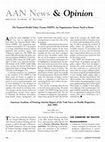
Nursing Outlook, 2003
A mong the many highlights of this past year was my opportunity to learn about the National Healt... more A mong the many highlights of this past year was my opportunity to learn about the National Health Policy Forum (NHPF). This nonpartisan organization was founded in 1971. Its purpose is to forge relationships between federal legislative and executive agency staff working in health care. The NHPF also teaches Hill staff and other key policy analysts (eg, Institute of Medicine, General Accounting Office) about hot health policy topics to foster more informed decisions. The founder of the NHPF, Judith Miller Jones, remains the Director of this 501c3 organization based at George Washington University in Washington, D.C. A steering committee was established at the inception of the NHPF to help define topics of interest to congress, to identify articulate speakers with topic expertise to serve as panel participants, and to secure funding. It is the timeliness of the topics that is the drawing card for the audience who attend by invitation only. Over the past year the sessions, held on an as-needed-basis, covered various aspects of Medicaid, the Medicare prescription drug benefit, disease management, oral
Journal for Nurses in Professional Development, 2013
In clinical practice, nurses are expected to understand and implement the science that supports p... more In clinical practice, nurses are expected to understand and implement the science that supports patient care, yet they fall short of goals to implement evidence in practice. One reason is difficulty in interpreting research results. Interpretation requires an ability to read and speak a language that many nurses have never mastered-the language of data. This article presents a skill-based solution for use in nursing professional development to improve nurses' understanding of statistics as a language.

Policy, Politics, & Nursing Practice, 2010
Health policy makers, providers, clinicians, and social scientists are among those who have ident... more Health policy makers, providers, clinicians, and social scientists are among those who have identified racial and ethnic diversification of the health care workforce as one strategy for solving the seemingly intractable problem of health disparities in the U.S. population. But evidence supporting the impact of such diversification on narrowing health disparities is lacking, thus making it unclear if the push for workforce diversification is empirically or politically driven. Moreover, data are largely derived from the study of physicians, making it difficult to generalize findings to nursing and other health professions. This article reviews the evidence that supports the impact of a diverse workforce on patient outcomes and delivery services. Assuming a positive social value in the absence of the data, the authors review the approaches that have been successful in diversifying the nursing workforce. The authors conclude with recommendations for research and policies, including best...
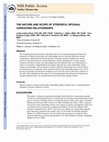
Journal of Family Nursing, 2011
The caregiving literature provides compelling evidence that caregiving burden and depressive symp... more The caregiving literature provides compelling evidence that caregiving burden and depressive symptoms are linked with stressful care relationships, however, relational difficulties around caregiving are seldom described in the literature. This article presents findings from content analysis of baseline interviews with 40 Alzheimer’s disease (AD) and Parkinson’s disease (PD) spousal caregivers enrolled in a home care skill-training trial who identified their care relationship as a source of care burden. Disappointment and sadness about the loss of the relationship; tension within the relationship; and care decision conflicts within the relationship were recurrent themes of relational stress in caregiving. These spousal caregivers had relationship quality scores below the mean and burden and depressive symptom scores above the means of other caregivers in the study. These findings provide support for developing dyadic interventions that help spouses manage relational losses, care-rela...
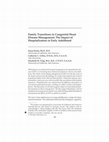
Journal of Family Nursing, 1999
With advances in medical and surgical management of congenital heart disease (CHD), it is becomin... more With advances in medical and surgical management of congenital heart disease (CHD), it is becoming more common for patients to survive into adulthood. This article reviews family management of CHD over the life course of the disease and presents the findings of a study of the psychosocial needs of hospitalized adults with CHD and their families. Thirty-four patients, family members, and nurses were interviewed for their perceptions of the hospital experience. Hospitalization was characterized by differing expectations of care between participant groups, resulting in conflict, tension, and dissatisfaction. This dissonance in care had a negative impact on individual and family transitions in illness management. The data suggest that family-centered standards of nursing practice based on an understanding of both the physical and psychosocial effects of CHD on adults are needed.
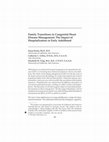
Journal of Family Nursing, 1999
With advances in medical and surgical management of congenital heart disease (CHD), it is becomin... more With advances in medical and surgical management of congenital heart disease (CHD), it is becoming more common for patients to survive into adulthood. This article reviews family management of CHD over the life course of the disease and presents the findings of a study of the psychosocial needs of hospitalized adults with CHD and their families. Thirty-four patients, family members, and nurses were interviewed for their perceptions of the hospital experience. Hospitalization was characterized by differing expectations of care between participant groups, resulting in conflict, tension, and dissatisfaction. This dissonance in care had a negative impact on individual and family transitions in illness management. The data suggest that family-centered standards of nursing practice based on an understanding of both the physical and psychosocial effects of CHD on adults are needed.

Journal of Women's Health & Gender-Based Medicine, 2001
This report examines the impact of individualized, population-based recruitment and retention app... more This report examines the impact of individualized, population-based recruitment and retention approaches on the development of a subject pool, enrollment, and retention at 12 months of healthy, community-based women in three ethnic groups: African Americans, non-Hispanic European Americans, and Mexicans/Central Americans. Of 722 women contacted and screened, 346 (48%) were eligible and consented to participate. Attrition at 12 months was low (10%) compared with other published reports. The largest group of potential subjects was identified through broadcast media approaches, but this method produced the highest number of ineligible women and highest rate of attrition. Printed matter produced the next largest group of potential subjects, but ineligibility was high (53%). Face-to-face interactions enrolled the highest proportion of eligible women (84%) and lowest overall attrition (7%). Direct referral yielded fairly efficient enrollments (57%) and average attrition. Multiple approaches for recruitment can produce a diverse sample of healthy, community-based women. Face-to-face recruitment results in the highest yield of participants with the lowest attribution but is presumed to require more resources.
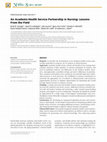
Journal of Nursing Scholarship, 2012
Purpose: To describe the development of an academic-health services partnership undertaken to imp... more Purpose: To describe the development of an academic-health services partnership undertaken to improve use of evidence in clinical practice. Approach: Academic health science schools and health service settings share common elements of their missions: to educate, participate in research, and excel in healthcare delivery, but differences in the business models, incentives, and approaches to problem solving can lead to differences in priorities. Thus, academic and health service settings do not naturally align their leadership structures or work processes. We established a common commitment to accelerate the appropriate use of evidence in clinical practice and created an organizational structure to optimize opportunities for partnering that would leverage shared resources to achieve our goal. Findings: A jointly governed and funded institute integrated existing activities from the academic and service sectors. Additional resources included clinical staff and student training and mentoring, a pilot research grant-funding program, and support to access existing data. Emergent developments include an appreciation for a wider range of investigative methodologies and crossdisciplinary teams with skills to integrate research in daily practice and improve patient outcomes. Conclusions: By developing an integrated leadership structure and commitment to shared goals, we developed a framework for integrating academic and health service resources, leveraging additional resources, and forming a mutually beneficial partnership to improve clinical outcomes for patients. Clinical Relevance: Structurally integrated academic-health service partnerships result in improved evidence-based patient care delivery and in a stronger foundation for generating new clinical knowledge, thus improving patient outcomes. Partnerships between academic and health service centers are increasingly valuable. Healthcare needs of the global population are changing, focusing more on quality and safety of care, the aging population, a limited health economy, and health policies that demand resizing the workforce. Academic service partnerships can contribute significantly to an effective response, as highlighted in recent reports on the future of nursing (Front Line Care,

This book is a jam-packed resource for nurse clinicians, graduate students, faculty, and research... more This book is a jam-packed resource for nurse clinicians, graduate students, faculty, and researchers. It is assumed that the reader will have some basic knowledge of family nursing. However, four theoretical perspectives that have contributed to family practice are addressed in depth. The family system is seen as the unit of nursing care. Both wellness and illness are discussed from this framework. For example, a chapter on child day care and an appendix of day-care resources are extremely pertinent. More than half of the women with preschoolers in this country are employed in the work force. Much emphasis is placed on chronic health problems across the life span, and specific disease processes are explored within the context of family nursing. The chapter on culture and family can provide useful information for the community health nurse (CHN) who must deal with a global society. The CHN also can draw on the strategy of caseload analysis as presented in the chapter on health-care policy. Little space is given to the topic of alternate family forms. The authors argue that family strengths serve as the critical factor rather than family structure. The CHN interacts with the traditional nuclear family as well as other family forms. Thus, more information about the single parent, stepfamily, and gay/lesbian family would have been helpful. An interesting and innovative component in the book is the use of the camera as a research tool. Several photoessays are included. Such visual data provide new insights and understandings. This is such a powerful experience that one is left with the impression that every CHN should carry a camera in the traditional black bag.
Journal of Gerontological Nursing, Apr 1, 2008

Journal of Family Nursing, 2011
The caregiving literature provides compelling evidence that caregiving burden and depressive symp... more The caregiving literature provides compelling evidence that caregiving burden and depressive symptoms are linked with stressful care relationships, however, relational difficulties around caregiving are seldom described in the literature. This article presents findings from content analysis of baseline interviews with 40 Alzheimer's disease (AD) and Parkinson's disease (PD) spousal caregivers enrolled in a home care skill-training trial who identified their care relationship as a source of care burden. Disappointment and sadness about the loss of the relationship; tension within the relationship; and care decision conflicts within the relationship were recurrent themes of relational stress in caregiving. These spousal caregivers had relationship quality scores below the mean and burden and depressive symptom scores above the means of other caregivers in the study. These findings provide support for developing dyadic interventions that help spouses manage relational losses, care-related tensions, and care decision-making conflicts.

Policy, Politics, & Nursing Practice, 2010
Health policy makers, providers, clinicians, and social scientists are among those who have ident... more Health policy makers, providers, clinicians, and social scientists are among those who have identified racial and ethnic diversification of the health care workforce as one strategy for solving the seemingly intractable problem of health disparities in the U.S. population. But evidence supporting the impact of such diversification on narrowing health disparities is lacking, thus making it unclear if the push for workforce diversification is empirically or politically driven. Moreover, data are largely derived from the study of physicians, making it difficult to generalize findings to nursing and other health professions. This article reviews the evidence that supports the impact of a diverse workforce on patient outcomes and delivery services. Assuming a positive social value in the absence of the data, the authors review the approaches that have been successful in diversifying the nursing workforce. The authors conclude with recommendations for research and policies, including best practices, for enhancing recruitment and retention of a diverse nursing workforce.

Http Dx Doi Org 10 1080 08964280009595752, Mar 25, 2010
The number of indicators of chronic disease management is large and no practical framework is ava... more The number of indicators of chronic disease management is large and no practical framework is available to guide selection for use in intervention programs. In addition, it is often difficult to integrate multiple disease management indicators into a comprehensive picture of patient functioning. The authors present a heuristic framework for creating a profile of disease management and an empirically based descriptive typology of disease management behavior. From the literature, they identified 5 domains of disease management indicators: biologic, general health and functional status, emotional tone, quality of life, and behavioral. They selected 11 scales and assessed 187 patients with type 2 diabetes. Five statistically replicable patient disease management types were derived from exploratory and confirmatory cluster analyses and a descriptive narrative was created for each: balanced (33%), problematic (6%), coasters (34%), discouraged (16%), and distressed (11%). The typology describes different presentations of disease management that can be linked with patient-tailored interventions for patients with type 2 diabetes.
J Am Acad Nurse Pract, 2005
Uploads
Papers by Catherine Gilliss